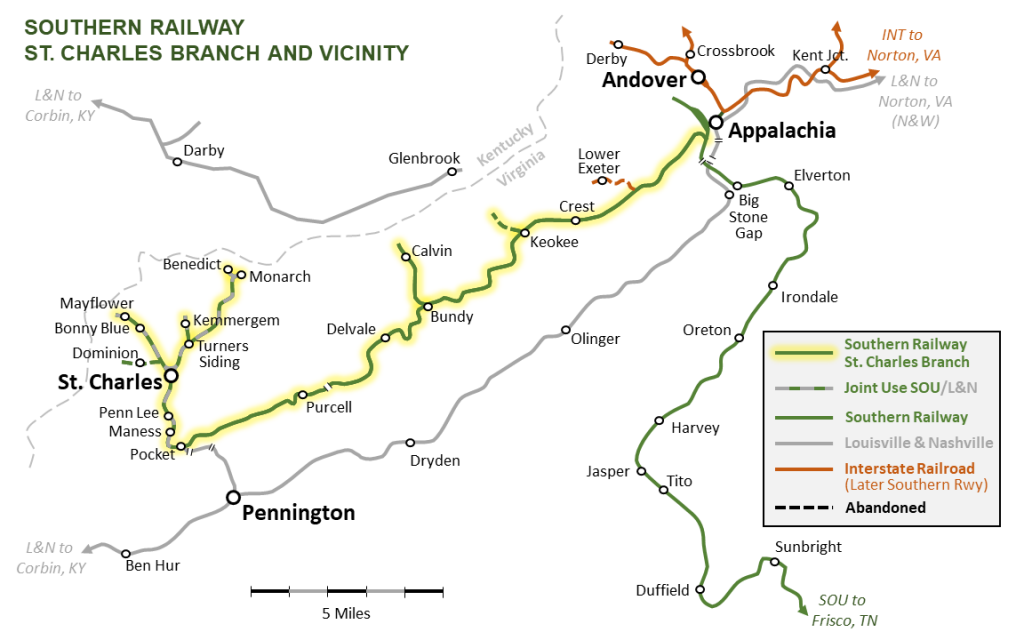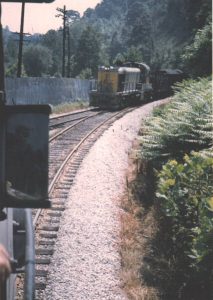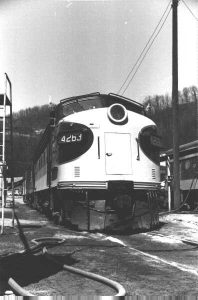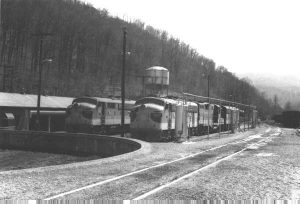

The St. Charles Branch of the Southern Railway was the primary source of online coal on the Southern’s Appalachia Division which ran through southwestern Virginia and eastern Tennessee. The line stretches more than 20 miles from the town of Appalachia, Virginia to the finger-like creeks north of St. Charles, Virginia. This line, along with a lot of help from its next door neighbor, the Interstate Railroad, kept the Appalachia Division rolling with black diamonds.
History. The St. Charles Branch began life as the Black Mountain Railway. Organized in 1903, it was authorized to construct an operate a railway from a junction with the Louisville & Nashville Railroad at or near Pennington, Virginia up the North Fork of the Powell River and Straight Creek along with its tributaries. Financing for the project was supplied primarily by the Black Mountain Coal & Coke Company through an exchange of stock.
After initial construction and brief operation, Black Mountain Coal & Coke sold its shares of the Black Mountain Railway to the Virginia & Southwestern in 1905. The V&SW was a growing coal hauler and quickly set out to build a connecting line with the Black Mountain from Appalachia to Pocket, VA. The connection was completed in 1907. In the meantime, the Black Mountain had built a station and small yard at St. Charles and completed several branches along the creeks north of St. Charles to serve the many coal operations in the area.


To settle a dispute with the L&N, the Black Mountain Railway granted the L&N joint use over its line “in perpetuity.” The L&N worked the line from its connection with the Black Mountain at Pocket and fed L&N-bound coal via its short branch to the L&N’s Cumberland Valley Division mainline at Pennington, VA.
In 1908, stockholders formally approved the sale of the Black Mountain Railway to the V&SW, a formality since the V&SW had effectively been operating the railroad already. After a series of financial woes and disputes, the V&SW itself was leased to the Southern Railway in 1916, and it became an integral part of the Southern’s Appalachia Division.
While coal operators came and went over the years, operations on the St. Charles Branch remained essentially the same for decades. Major tipples on were located at Dominion, Mayflower, Bonny Blue, Darby (Kemmergem), Monarch, Imperial, Benedict, Keokee and Calvin. Smaller truck dumps dotted the line as well, especially in the Pocket area. Southern mine runs operated out of Appalachia and St. Charles supplying mines with empties, and coal loads moved to the yard at Appalachia where they were either moved south on the Southern along with loads received from the Interstate or interchanged with the L&N and Interstate to move to other points south and east (the Interstate connected with the Norfolk & Western and the Clinchfield).

In 1960, the Southern Railway purchased the Interstate Railway, and in 1965 consolidated yard operations at the Interstate’s Andover Yard, a couple miles from Appalachia. The Appalachia Yard became home to the massive Westmoreland Coal transloader which cleaned and blended coal from area mines and shipped it out in unit trains of 100-ton cars. Many of the tipples on both the St. Charles Branch and Interstate shipped coal to the transloader, and the Southern employed a hodgepodge fleet of old beat up 50- and 70-ton hoppers (including the Interstate Railroad’s black 50T hoppers) known as “yellow balls” in this captive service.
1982 saw the merger of the Southern and Norfolk & Western under the Norfolk Southern, but the lines initially operated as they had for decades. In an effort to consolidate mine run operations of the two partner railroads in 1985, the NS transferred the St. Charles Branch, along with the former Interstate Railroad, to the Norfolk & Western’s Pocahontas Division, Clinch Valley Extension. While this changed operating patterns significantly for the Interstate, the St. Charles Branch was operated more or less the same, though unit trains from both the NS and L&N successor CSX replaced most of the mine runs.
Operations
Under the Southern Railway, operations on the St. Charles Branch were pretty straightforward. The Southern operated between two and four mine runs most days. Mine runs were split between St. Charles and Appalachia. One set of power (typically two 4-axle units in the diesel era) and a cab was based at St. Charles, and the “St. Charles Mine Runs” were called 1-2 times a day to work the loaders on the branches north of St. Charles and the loaders between St. Charles and Pocket.
The remaining mine runs worked out of the Appalachia area, from Appalachia Yard up until 1965 and Andover Yard afterward. These mine runs were known as the “St. Charles Local” (train 61/60 on the Southern timetable), the “Black Mountain Local,” and in the ’80s the “Crest and Crossbrook Switcher.” The locals worked the loaders between Appalachia and St. Charles and shuttled empties and loads gathered by the St. Charles Mine Runs between St. Charles and Appalachia/Andover. Power was typically 2-4 4-axle units, and after 1965, the locals could often be found working the transloader at Appalachia. The Crest and Crossbrook Switcher was added later (’80s?) and typically worked nightly between Andover and the busy loader at Crest on the east end of the St. Charles Branch.
The L&N served the western end of the branch with its own mine run, the “Cumberland Valley Local” or “CV Local”, train 179/180 on the timetable. In the 1960s, the CV Local was a humble train, usually just a handful of hoppers and cab pulled by a single RS3. The L&N discontinued its mine run for a while in the ’70s when the tunnel at Pocket fell into disrepair, but trains were continued in the mid ’80s with the introduction of a couple of flood loaders north of St. Charles. While the Southern continued to work the area with 4-axle power, the Seaboard System (successor to the L&N) used burly SD50s and other 6-axles on its unit trains. The NS later followed suit.
Regardless of the era or railroad, the St. Charles Branch was coal, coal and more coal! There was a team track at St. Charles and a siding just north at Turners Siding that lasted until around 1960 (perhaps a mining supply company)–everything else was coal loaders. Even then, an occasional boxcar or flatcar of supplies, tank car of oil or antifreeze, and covered hoppers of fertilizer (used in making blasting powder) might be found mixed in among the hundreds of hoppers that plied these rails daily.
Little has been written on the St. Charles Branch, and the information here has been pieced together from several sources. If you have additional information to add to the prototype history and operations, I would be very grateful! Please leave a comment below.
References:
Wolfe, Ed. Southern Railway Appalachia Division. HEW Enterprises, 2010
Wolfe, Ed. The Interstate Railroad. Old Line Graphics, 1994

Giving me several ideas on my freelanced West Virginia Division of the Indian Rock Railway
Good to hear! It’s always good to study track plans–I never saw a track plan I didn’t learn something from.
Very exciting Dan! Can’t wait to see more progress.